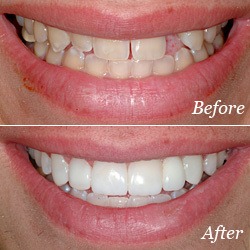
If you’re considering a dental bridge, you may wonder about dental bridge esthetics and whether dental bridges look like natural teeth. Modern dentistry aims to create bridges that seamlessly blend with your existing teeth, making them virtually indistinguishable. These bridges are carefully designed to match the color, shape, and size of your teeth, ensuring a natural appearance. They are typically crafted from porcelain or ceramic, which mimic the appearance of natural teeth and reflect light similarly. Dentists use their expertise to ensure the bridge fits comfortably and harmoniously in your mouth, restoring your smile with dental implants that look like natural teeth.
In summary, dental bridges are a natural-looking solution for missing teeth, with dental implant esthetics that closely mimic the appearance of real teeth. Made from high-quality materials and expertly fitted by dentists, they seamlessly blend with your existing teeth to provide a long-lasting and aesthetically pleasing solution.

Do Dental Bridges Look Natural?
Dental bridges are a popular solution for replacing missing teeth. They are designed to blend in seamlessly with your natural teeth, providing a natural-looking smile. But do dental bridges really look natural? Let’s explore this topic in more detail.
How Do Dental Bridges Work?
- Dental bridges consist of pontics (artificial teeth) supported by dental crowns.
- Crowns are placed on adjacent teeth to support the pontics and bridge the gap left by missing teeth.
- This creates a fixed prosthetic with a natural appearance and function.
- Dentists consider factors like color, shape, and size of pontics and crowns during design.
- The aim is to seamlessly integrate the bridge with existing teeth, improving aesthetics, chewing, and speech.
The Materials Used for Dental Bridges
- Dental bridges can be constructed from various materials, such as porcelain, ceramic, and metal alloys.
- Porcelain and ceramic bridges are preferred for their close resemblance to natural teeth in appearance.
- These materials are also stain-resistant, ensuring the long-term maintenance of a natural look.
- Metal alloy bridges, while durable and strong, may not offer the same aesthetic appeal as porcelain or ceramic.
- Metal alloy bridges are often chosen for posterior teeth or less visible areas of the mouth.
- Your dentist will recommend the most appropriate material based on your individual requirements and preferences.
The Importance of Proper Fit and Placement
In addition to the materials used, the fit and placement of your dental bridge play a crucial role in achieving a natural look. Your dentist will carefully evaluate your bite and ensure that the bridge fits snugly against your gums and adjacent teeth. This not only ensures a comfortable fit but also enhances the natural appearance of the bridge.
If a dental bridge is poorly fitted or placed, it can cause discomfort and affect your ability to chew and speak properly. It may also look unnatural and stand out, diminishing the overall aesthetics of your smile. That’s why it’s essential to choose an experienced dentist who specializes in restorative dentistry to ensure the best results.
Benefits of Dental Bridges
Dental bridges offer several benefits beyond their natural appearance. Here are some of the advantages of choosing dental bridges to replace missing teeth:
1. Improved appearance: Dental bridges fill in the gaps left by missing teeth, enhancing the overall appearance of your smile.
2. Restored functionality: By replacing missing teeth, bridges restore your ability to chew and speak properly.
3. Maintained facial structure: Missing teeth can cause a sunken appearance in the cheeks. Bridges help maintain the natural shape of your face.
4. Preventing tooth shifting: When a tooth is missing, adjacent teeth may start to shift into the empty space. Bridges prevent this from happening, preserving the alignment of your teeth.
5. Cost-effective solution: Compared to other tooth replacement options like dental implants, bridges are a more affordable solution for many patients.
Choosing the Right Dental Bridge
When considering dental bridges, it’s important to consult with your dentist to determine the best option for your specific needs. Your dentist will evaluate your oral health, discuss your goals and preferences, and recommend the most suitable type of bridge.
There are different types of dental bridges available, including traditional bridges, cantilever bridges, and Maryland bridges. Each type has its own advantages and considerations, so it’s crucial to work with your dentist to make an informed decision.
In conclusion, dental bridges can indeed look natural when designed and placed correctly. With advancements in dental materials and techniques, it is possible to achieve a seamless blend between the bridge and your natural teeth. By choosing dental bridges, you can restore your smile and regain your confidence with a natural-looking, functional solution.
Key Takeaways: Do Dental Bridges Look Natural?
- Dental bridges can look natural and blend in seamlessly with your existing teeth.
- The materials used for dental bridges, such as porcelain, can mimic the appearance of natural teeth.
- A skilled dentist can customize the shape, size, and color of the dental bridge to match your natural teeth.
- Proper maintenance and regular dental check-ups can help ensure the longevity and natural appearance of dental bridges.
- Consulting with a dentist will help determine if dental bridges are the right option for your specific dental needs.
Frequently Asked Questions
Are dental bridges noticeable?
Modern dental bridges are designed to address concerns about their visibility, offering an aesthetically pleasing solution. These bridges seamlessly blend with your natural teeth, significantly reducing their noticeability. The color of the bridge can be precisely matched to your natural teeth, ensuring a seamless integration, while its shape and size are customized to fit your mouth, resulting in a harmonious and natural appearance.
With the expertise of a skilled dental professional, dental bridges can be virtually indistinguishable from your natural teeth, providing a confident and inconspicuous solution.
Do dental bridges look fake?
Dental bridges, when well-designed and crafted, do not appear fake. Dentists prioritize factors like shape, size, color, and texture to achieve a natural look. Materials like porcelain and ceramic closely mimic tooth enamel, and advancements in dentistry ensure long-lasting esthetic results with proper care.
Will others be able to tell if I have a dental bridge?
Dental bridges are expertly designed to be nearly invisible, seamlessly matching your natural teeth in color, shape, and size. The appearance largely relies on the proficiency of the dental professional. Collaborating with an experienced dentist or prosthodontist enhances the likelihood of achieving a perfectly natural-looking result.
How long do dental bridges last?
The lifespan of a dental bridge can vary depending on various factors, including oral hygiene practices, diet, and overall oral health. With proper care and maintenance, dental bridges can last anywhere from 5 to 15 years or even longer.
To maximize the lifespan of your dental bridge, it’s important to maintain good oral hygiene habits, including regular brushing and flossing. Visiting your dentist for regular check-ups and cleanings can also help detect any potential issues with your dental bridge early on and ensure its longevity.
Can dental bridges stain or discolor over time?
High-quality dental bridges, typically made of materials like porcelain or ceramic, are resistant to staining. However, habits like consuming staining foods and smoking can affect their appearance over time. To maintain a natural look, avoid such habits and prioritize good oral hygiene and dental cleanings.
Final Thought: Do Dental Bridges Look Natural?
Modern dentistry has advanced significantly, enabling dental bridges to achieve a remarkably natural appearance. These bridges are meticulously designed to seamlessly blend with your natural teeth, thanks to high-quality materials like porcelain or ceramic crowns that mimic natural teeth in color and translucency. Careful attention is also given to the bridge’s shape, size, and positioning to ensure it harmonizes with your facial features and bite alignment.
Beyond aesthetics, dental bridges offer functional benefits by restoring proper chewing and speech capabilities, preventing potential oral health issues caused by missing teeth. With proper care, these bridges can last for years, ensuring a long-lasting, natural-looking smile. If you’re considering dental bridges to address missing teeth, consult a dental professional for personalized guidance and enjoy the confidence of a complete and natural smile.
Call or Book appointment online
:Ace Dental Care Alpharetta office: 678-562-1555 - Book Now
Ace Dental Care Norcross office: 770-806-1255 - Book Now
Disclaimer
This blog post was generated by artificial intelligence. The content of this post may not be accurate or complete, and should not be relied upon as a substitute for professional advice. If you have any questions about the content of this post, please contact us.
We are constantly working to improve the accuracy and quality of our AI-generated content. However, there may still be errors or inaccuracies. We apologize for any inconvenience this may cause.





